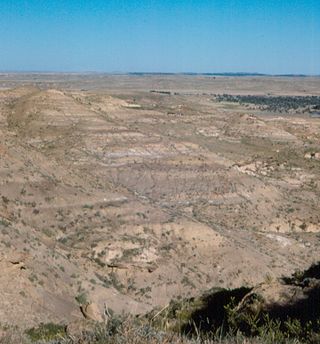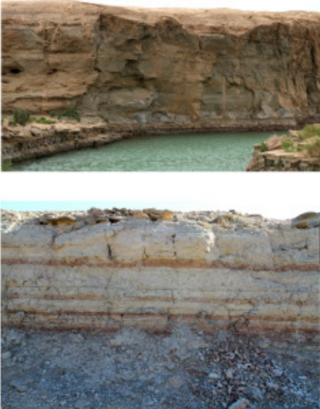| Xiaoyan Formation | |
|---|---|
| Stratigraphic range: | |
| Type | Geological formation |
| Unit of | Huangshan Basin |
| Sub-units | Lower; Upper members |
| Underlies | Qiyunshan Formation |
| Location | |
| Region | Asia |
The Xiaoyan Formation is a geological formation in Anhui, China whose strata date back to the Late Cretaceous. Dinosaur remains are among the fossils that have been recovered from the formation. [1] It overlies the older Qiyunshan Formation which it forms the Huangshan Basin with, and was deposited between the Campanian and Maastrichtian stages. [2]

Weald Clay or the Weald Clay Formation is a Lower Cretaceous sedimentary rock unit underlying areas of South East England, between the North and South Downs, in an area called the Weald Basin. It is the uppermost unit of the Wealden Group of rocks within the Weald Basin, and the upper portion of the unit is equivalent in age to the exposed portion of the Wessex Formation on the Isle of Wight. It predominantly consists of thinly bedded mudstone. The un-weathered form is blue/grey, and the yellow/orange is the weathered form, it is used in brickmaking.

The Lance (Creek) Formation is a division of Late Cretaceous rocks in the western United States. Named after Lance Creek, Wyoming, the microvertebrate fossils and dinosaurs represent important components of the latest Mesozoic vertebrate faunas. The Lance Formation is Late Maastrichtian in age, and shares much fauna with the Hell Creek Formation of Montana and North Dakota, the Frenchman Formation of southwest Saskatchewan, and the lower part of the Scollard Formation of Alberta.

The Cloverly Formation is a geological formation of Early and Late Cretaceous age that is present in parts of Montana, Wyoming, Colorado and Utah in the western United States. It was named for a post office on the eastern side of the Bighorn Basin in Wyoming by N.H. Darton in 1904. The sedimentary rocks of formation were deposited in floodplain environments and contain vertebrate fossils, including a diverse assemblage of dinosaur remains. In 1973, the Cloverly Formation Site was designated as a National Natural Landmark by the National Park Service.
The Xīnmínbǎo Group is a group of geological formations in north central China. They occur across a large depression between the Altai mountains of Mongolia to the north and the Qilian mountains of the Qinghai Plateau to the south, in the Gōngpóquán (公婆泉) and Suànjǐngzi (算井子) basins, and also in the neighbouring Jiuquan Basin.
The Houcheng Formation is a geological formation in Hebei, China whose strata date back to the Upper Middle Jurassic. The lithology primarily consists of sandstone and conglomerate deposited in fluvial, alluvial fan and fan delta conditions, with interbeds of volcanic rocks. Dinosaur remains are among the fossils that have been recovered from the formation.

The Tugulu Group is a geological Group in Xinjiang, China whose strata date back to the Early Cretaceous. Dinosaur skeletal remains and footprints are among the fossils that have been recovered from the formation.
The Zhidan Group is a geological formation in China whose strata date back to the Early Cretaceous. Dinosaur remains are among the fossils that have been recovered from the formation.
The Dashuigou Formation is a geological formation in Inner Mongolia, north China, whose strata date back to the Early Cretaceous period.
The Yijinholuo Formation is a geological formation in Inner Mongolia, China whose strata date back to the Early Cretaceous. Dinosaur remains are among the fossils that have been recovered from the formation.
The Denver Formation is a geological formation that is present within the central part of the Denver Basin that underlies the Denver, Colorado, area. It ranges in age from latest Cretaceous (Maastrichtian) to early Paleocene, and includes sediments that were deposited before, during and after the Cretaceous-Paleogene boundary event.
The El Picacho Formation is a geological formation in Texas, United States, whose strata date back to the Late Cretaceous. Dinosaur remains are among the fossils that have been recovered from the formation. The paleosols found here are rich in clay, calcite, and rhizoliths which show that during the Cretaceous period, this fossil formation, just like the neighboring Javelina Formation and Aguja Formation, was a fluvial flood plain.
The Claggett Shale is a geological formation in Montana whose strata date back to the Late Cretaceous. Dinosaur remains are among the fossils that have been recovered from the formation.
The Livingston Group is a geological formation in Montana whose strata date back to the Late Cretaceous. Dinosaur remains are among the fossils that have been recovered from the formation.

The Frontier Formation is a sedimentary geological formation whose strata date back to the Late Cretaceous. The formation's extents are: northwest Colorado, southeast Idaho, southern Montana, northern Utah, and western Wyoming. It occurs in many sedimentary basins and uplifted areas.
The Evanston Formation is a geological formation in Wyoming whose strata date back to the Late Cretaceous. Dinosaur remains are among the fossils that have been recovered from the formation. The fossil formation also has the remains of prehistoric mammals from the Paleocene epoch.
La Bocana Roja Formation is a geological formation in Baja California, Mexico whose strata date back to the Late Cretaceous. Dinosaur remains are among the fossils that have been recovered from the formation.
The Shanyang Formation is a geological formation in Shaanxi whose strata date back to the Late Cretaceous. Dinosaur remains are among the fossils that have been recovered from the formation.
The Minhe Formation is a geological formation in northwestern China, whose strata date back to the Late Cretaceous period.
The Zhumabao Formation is a geological formation in Shanxi, China whose strata date back to the Late Cretaceous. Dinosaur remains are among the fossils that have been recovered from the formation.
The Yuliangze Formation, or Yuliangzi Formation, is a geological formation in Heilongjiang, China whose strata date back to the early-middle Maastrichtian. Dinosaur remains are among the fossils that have been recovered from the formation.